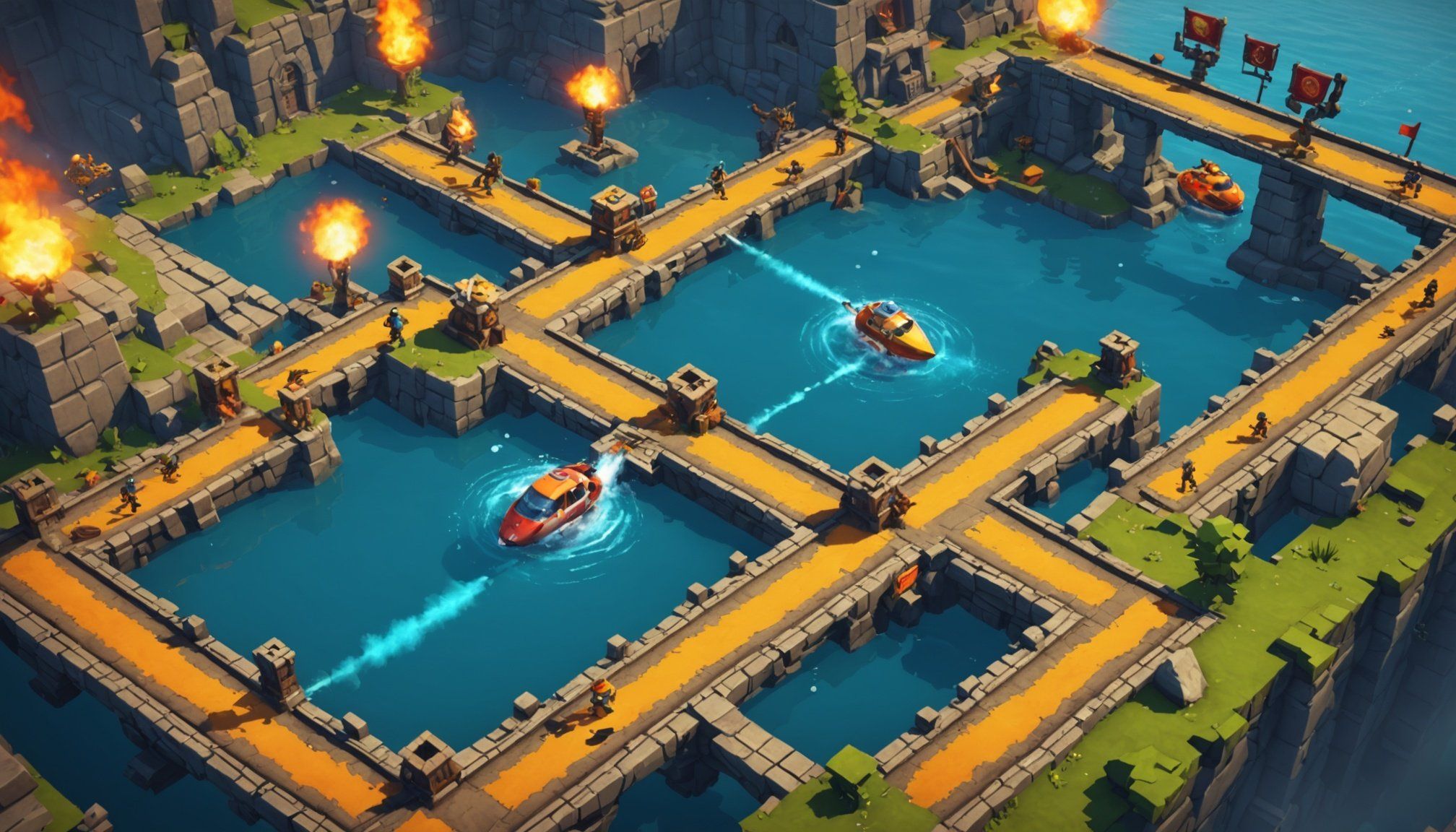Technical Limitations in Cross-Platform Development
Cross-platform game development presents a set of unique technical challenges. One of the foremost issues is ensuring game development processes meet the diverse cross-platform compatibility requirements. Developers face technical constraints when building multiplayer games that must operate smoothly on various devices and platforms.
Different hardware and software configurations result in performance disparities. A game that runs seamlessly on a high-end PC might encounter lag or graphics issues on a mobile device. Addressing these disparities is crucial to maintaining a uniform gaming experience for all players.
Also to see : Mastering Winter Sports in Game Development: Key Techniques for Realistic Snow and Ice Physics
Strategies to overcome these challenges include optimizing gameplay experiences tailored to each device. This might involve adjusting graphics settings or streamlining code to reduce processing demands across platforms. Additionally, utilizing cross-platform engines, such as Unity or Unreal Engine, can help standardize the development process, ensuring better cross-platform compatibility.
To further enhance performance, developers may adopt middleware tools designed to facilitate communication between different hardware ecosystems. Such tools contribute to minimizing performance gaps, thus improving the overall user experience. By addressing these technical challenges, developers can create engaging and accessible games for a wider audience.
In the same genre : Mastering Stealth: Innovative Dynamic Lighting Techniques for a Truly Immersive Video Game Experience
Ensuring Consistent Player Experience
To deliver a uniform player experience across various platforms, consistency in gameplay mechanics is paramount. Games must provide identical rules, control schemes, and progression systems to ensure fairness and maintain user engagement. Variations in control inputs between consoles and PCs often pose a challenge; thus, developers can refine control mapping to ensure intuitive interactions for all players.
Performance and game design must also remain consistent. Variations in hardware capabilities, from high-end consoles to budget smartphones, can lead to different performance experiences. Maintaining uniform graphics and performance calls for adaptive solutions like dynamic resolution scaling and frame rate adjustments based on device capabilities. Utilizing a graphics engine that can scale visuals efficiently ensures players with diverse devices enjoy similar visual fidelity.
Examples like “Fortnite” and “Rocket League” illustrate success in offering cohesive gameplay experiences across platforms. These games deploy robust back-end systems that synchronize player data and gameplay states seamlessly, regardless of platform. By focusing on user engagement through consistent mechanics and aesthetics, developers create a reliable and enjoyable experience, fostering widespread player satisfaction. These efforts illustrate that a meticulous approach to cross-platform game design can captivate audiences without compromising on quality.
Addressing Platform Compatibility Issues
Ensuring smooth platform integration is pivotal in cross-platform game development. Developers often face compatibility challenges due to varying gaming consoles and PC systems. Common issues arise from differences in operating systems, hardware specifications, and input methods. Such disparities can hinder cross-platform functionality, causing crashes or suboptimal performance.
To tackle these hurdles, adhering to best practices is essential. Emphasizing modular design aids in compartmentalizing game code, making it easier to adapt across platforms. Additionally, adopting adaptable APIs streamline processes, ensuring games remain functional and versatile. Thorough testing on multiple platforms before release helps preemptively identify potential incompatibility problems.
Examining case studies offers valuable insight. For example, the developers of “Minecraft” showcased effective cross-platform solutions by introducing the “Bedrock Edition,” which unified disparate platforms under one codebase. This strategy reduced compatibility issues and provided a consistent experience for players.
Another notable success is “Genshin Impact,” which efficiently balances platform compatibility by optimizing graphical settings and controls specifically for each device. By leveraging such methodologies, developers can navigate compatibility challenges confidently, ensuring their games provide optimal cross-platform functionality for diverse audiences.
Balancing the Competitive Landscape
Creating a fair competitive balance in cross-platform gaming invites significant challenges. Different platforms often feature distinct control mechanisms and reaction times, which can impact gameplay equity. Ensuring fair competition across these platforms necessitates thoughtful multiplayer matchmaking strategies.
One effective strategy is implementing crossplay support with adjustable skill thresholds. This system can match players based on skill level and platform, ensuring fair contests. Additionally, game developers can optimise algorithms that weigh control precision between consoles, PCs, and mobile devices to level the playing field.
To maintain competitive integrity, some games provide platform-specific tournaments or options to disable cross-platform play in ranked modes. Such approaches give players control over their gaming environment, fostering enjoyable and equal competition.
Examples like “Call of Duty: Warzone” highlight successful balancing. The game achieves fair matchmaking by segregating input types—such as mouse and keyboard versus controllers—ensuring players contend within comparable settings. This nuanced approach maintains excitement and engagement, drawing players into balanced and challenging encounters.
By integrating these strategies, developers create dynamic and vibrant multiplayer environments that respect player engagement while offering equitable competition across diverse platforms.
Community and Player Feedback Integration
Engaging the community in the development process is pivotal for crafting a well-rounded game development experience. Player feedback holds immense value in shaping games that resonate with diverse audiences. Understanding users’ needs helps developers address cross-platform compatibility issues more precisely.
Effective user feedback gathering techniques include in-game surveys, social media interactions, and dedicated forums. These platforms enable developers to solicit opinions and identify potential technical challenges early in game development. Moreover, player-driven improvements can significantly enhance cross-platform gameplay experiences by tailoring features to meet gamers’ expectations.
Success stories like “No Man’s Sky” demonstrate how integrating community input can transform a game’s reception. Initially released to mixed reviews due to technical limitations, the developers listened extensively to player feedback. By implementing requested features and improvements, they refined the game, ultimately earning widespread acclaim.
Dedicated community engagement not only boosts player satisfaction but also solidifies trust between developers and their audiences. By fostering open communication channels, studios can continuously evolve their games, ensuring they meet the ever-changing demands of cross-platform gamers. Involving players in the development journey leads to more captivating and successful gaming experiences.
Future Trends in Cross-Platform Multiplayer Games
The future of multiplayer gaming is set to be shaped by groundbreaking advancements in technology. Emerging technologies such as cloud gaming and virtual reality (VR) are at the forefront, promising to redefine how players interact across multiple devices. Cloud gaming, for instance, reduces the reliance on powerful local hardware by streaming games from remote servers, potentially bridging performance disparities across platforms.
Exciting innovations are underway to meet evolving user expectations. Players increasingly demand seamless gameplay experiences regardless of device, pushing developers to prioritise cross-platform compatibility. Adaptive AI, for example, can tailor game difficulty in real time, ensuring all players enjoy a balanced challenge irrespective of their gaming setup.
Looking ahead, predictions include widespread adoption of machine learning to optimise matchmaking processes, creating fairer competitive environments. Gaming trends point towards a future where voice and gesture controls become the norm, broadening accessibility and engagement.
These developments signify a paradigm shift in multiplayer game design strategies, focusing intensely on delivering consistent and captivating experiences. As technology continues to advance, the lines between platforms will blur, offering gamers unprecedented freedom to play when and where they choose.











